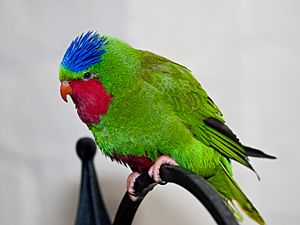Blue-crowned lorikeet facts for kids
Quick facts for kids Blue-crowned lorikeet |
|
|---|---|
 |
|
| Conservation status | |
| Scientific classification | |
| Genus: |
Vini
|
| Species: |
australis
|
The blue-crowned lorikeet (Vini australis) is a small, colorful parrot that lives on islands in the Pacific Ocean. You might also hear it called the blue-crowned lory or Samoan lory. This bird is about 19 centimeters (7.5 inches) long. It has bright green feathers, a red throat, and a special blue patch on its head. Its belly also shows a mix of red and purple colors.
These beautiful birds can be found across many islands. Their home includes the Lau Islands in Fiji, Tonga, Samoa, and Niue. They also live on other nearby islands like Futuna, Niuafoʻou, and ʻUpolu.
Contents
Discovering the Blue-Crowned Lorikeet
Scientists formally described the blue-crowned lorikeet in 1788. A German naturalist named Johann Friedrich Gmelin gave it its first scientific name. He included it in his updated book, which was based on the work of Carl Linnaeus. Gmelin called it Psittacus australis.
Gmelin learned about this bird from an English ornithologist, John Latham. Latham had described the "Blue crested parrakeet" in 1781. Latham thought his bird came from Hawaii, but he was mistaken. The bird actually came from the Samoan Islands. Today, the blue-crowned lorikeet is part of the Vini group of birds. This group name comes from a Tahitian word for a local bird.
Life of the Blue-Crowned Lorikeet
Blue-crowned lorikeets are still common in many areas. However, their numbers are decreasing on some islands. This decline seems to be due to predators like rats.
These lorikeets love areas with flowering trees. You can often spot them in coconut plantations and gardens. They usually fly in small groups of less than 15 birds. During the breeding season, they often fly in pairs.
What They Eat
Blue-crowned lorikeets have a special diet. They mostly eat nectar and pollen from flowers. They also enjoy soft fruits. Some of their favorite foods include wild hibiscus and coconuts.
Where They Live and Nest
These birds typically make their nests in holes found in trees. Sometimes, they might even dig burrows in earth banks to create a safe home for their young.


